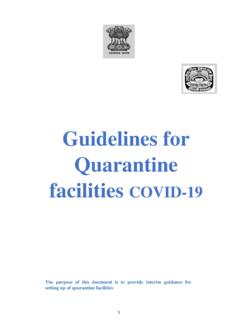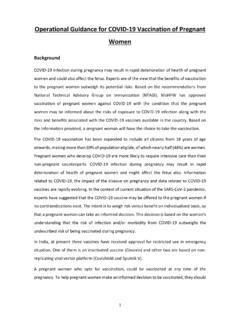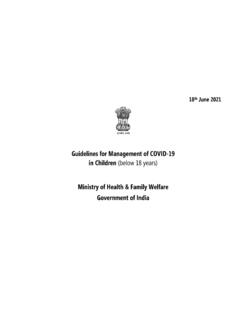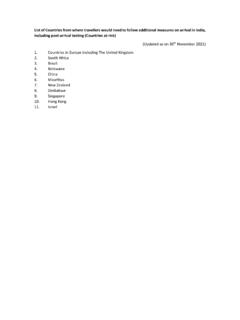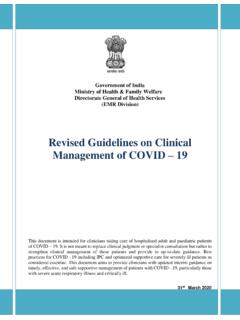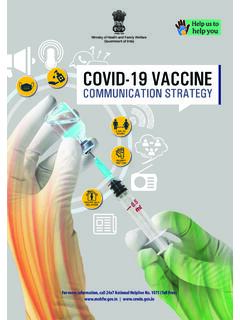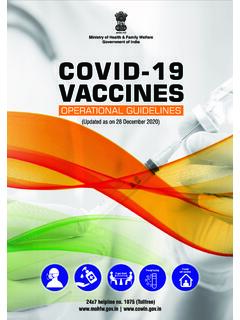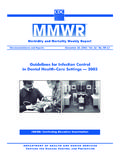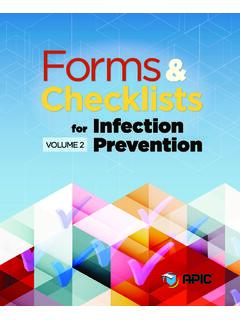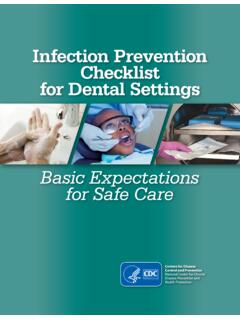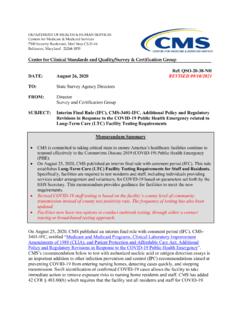Transcription of Ministry of Health and Family Welfare Government of India ...
1 Ministry of Health and Family WelfareGovernment of IndiaNATIONAL GUIDELINES FOR infection prevention AND CONTROL IN HEALTHCARE FACILITIESINFECTION prevention AND CONTROL PROGRAMMESWORKLOAD, STAFFING AND BED OCCUPANCYBUILT ENVIRONMENT, MATERIALS AND EQUIPMENTENABLING ENVIRONMENTEDUCATION & TRAININGSURVEILLANCEMULTIMODALSTRATEGIES MONITORING, AUDIT & FEEDBACKGUIDELINESN ational Guidelines forInfection prevention and Control in Healthcare FacilitiesNa onal Centre for Disease Control, Directorate General of Health ServicesMinistry of Health and Family Welfare , Government of IndiaJanuary 2020 Ministry of Health and Family Welfare , 2020 Messages.
2 Ix i Hon ble Health Minister .. ix i Secretary, Health and Family Welfare .. x i Special Secretary, Health and Family Welfare .. xi i WHO Representative to India ..xii i Joint Secretary, Health and Family Welfare .. xiii i Director, National Centre for Disease Control ..xivAcronyms ..xv1. Introduction .. 1 Scope and purpose .. 32. Fundamentals of Healthcare-Associated infections .. 5 Colonization and infection .. 7 Types of healthcare-associated infections .. 8 Routes of transmission .. 13 Basic concepts for prevention of HAI .. 14 Bundle approach for prevention and control of HAI .. 143. infection prevention and control programme .. 16 Objectives of the IPC programme.
3 16 Structure of IPC 16 Hospital infection control committee .. 16 Roles and responsibilities .. 18 infection prevention and control manual .. 26 Antimicrobial use and management .. 27 Educational programmes and strategies .. 29 Risk assessment and risk management .. 29 Planning, monitoring, audit and feedback .. 31 Implementation strategies .. 31 Evaluation and feedback of the programme .. 32 Contentsiv National Guidelines for infection prevention and Control in Healthcare Facilities4. Procedures and Practices for IPC .. 33 Standard precautions .. 33 Hand hygiene .. 34 Personal protective equipment.
4 38 Respiratory hygiene and cough etiquette .. 45 prevention of injuries from sharp .. 47 Safe handling of patient-care equipment .. 47 Principles of asepsis .. 52 Environmental infection control .. 52 Transmission-based precautions .. 54 Airborne 54 Droplet precautions .. 55 Contact precautions .. 555. Control of Environment .. 59 Air and Ventilation .. 59 Cleaning and sanitation .. 68 Safe water and food .. 73 Biomedical waste .. 826. IPC in special units or situations .. 89 A. IPC in surgical units .. 89 Aseptic protocols .. 89 Cleaning and disinfection .. 90 Infrastructure of OTs.
5 92 B. IPC in ICUs .. 93 Patients at risk of HAI .. 94 IPC practices .. 94 Bundle approach to prevent device-associated infections .. 95 Ventilator-associated pneumonia .. 95 Catheter-related bloodstream infection and CLABSI .. 97 Catheter-associated urinary tract infection .. 102 C. IPC in maternal and neonatal units .. 105 Maternal and neonatal infections .. 105 prevention of newborn and maternal infections during deliveries .. 106 Postpartum care of the mother .. 109 Postnatal care of the neonate .. 109 Contents vPrevention of infection during procedures in neonatal unit .. 112 D. IPC in outpatient and emergency care .. 113 Outpatient department.
6 113 E. IPC in dialysis units .. 115 IPC programme in the dialysis 115 F. IPC in immunocompromised patients .. 117 G. IPC practices in HCFs during epidemics/ pandemics .. 118 Challenges during epidemics .. 118 Preparing HCFs for an epidemic .. 119 IPC practices .. 120 H. IPC in clinical laboratory .. 121 General laboratory safety practices .. 122 Laboratory design and facilities .. 122 Laboratory dress code .. 123 Good personal habits .. 123 Risk assessment .. 124 Good housekeeping practices .. 125 Good laboratory practices .. 125 Biosafety levels .. 131 Safety equipment .. 132 Decontamination .. 133 Handling laboratory waste .. 1337. Healthcare-associated infections and their surveillance.
7 134 Surveillance of HAIs .. 134 Types of surveillance appropriate for HAIs .. 134 HAI surveillance with limited resources .. 135 Data sources .. 137 Surgical site infections .. 138 Classifi cation of surgical wound .. 140 Risk factors for SSI .. 140 Recommendations for the prevention of 142 CLABSI .. 146 National HAI surveillance network .. 152 Management of HAI outbreaks .. 152 Outbreaks vs clusters .. 152vi National Guidelines for infection prevention and Control in Healthcare Facilities Commonly detected organisms in HAI outbreaks .. 153 Identifying a potential outbreak .. 153 Steps involved in HAI outbreak investigation.
8 1548. Preventing infections among healthcare workers .. 165 Biological hazards .. 166 Human factors effecting safety .. 167 Training and education of HCWs .. 167 Safe work practice .. 168 Occupational Health programme .. 1689. References .. 17210. Annexes .. 1831. Acknowledgements .. 1842. IPC precautions pending confi rmation of diagnosis .. 1853. Observation forms for audit of hand hygiene compliance .. 1874. Post-exposure management for blood-borne infections , HIV, HBV and HCV .. 1915. Procedures for cleaning, disinfection and sterilization based on infection risk .. Procedures for cleaning and sanitation of environment.
9 Specifi c measures for environmental and equipment cleaning/disinfection in haemodialysis units .. 2096. Policy for visitors and attendants .. 2107. Airborne isolation, droplet and contact precautions for healthcare staff, patients and visitors .. 2118. Biomedical Waste Management and Handling Rules, 2016 .. Duties of occupier .. Schedule I: Biomedical waste categories and their segregation, collection, treatment, processing and disposal options .. Duties of operator of a common biomedical waste treatment and disposal facility .. Schedule II: Standards for treatment and disposal of biomedical waste .. Form IV, Annual Report.
10 2259. The operation theatre: preparation for surgery .. 229 Surgical attire, surgical scrub .. 229 Cleaning of operation theatre .. 230 Contents vii10. Ventilation and design requirements .. 23211. High-risk pathogens epidemic action plan .. 23312. Classifi cation of infective microorganisms by risk group .. 23613. Forms for surveillance of HAI .. Denominator data collection form .. BSI case report form .. UTI case report form .. Checklist for ventilator-associated pneumonia .. Surveillance periods for SSI following selected NHSN operative procedures .. 242 Message from Hon ble Health Minister Healthcare Associated infections (HAI) are one of the most common adverse events in delivery of care and a major public Health problem with an impact on morbidity, mortality and quality of life.

